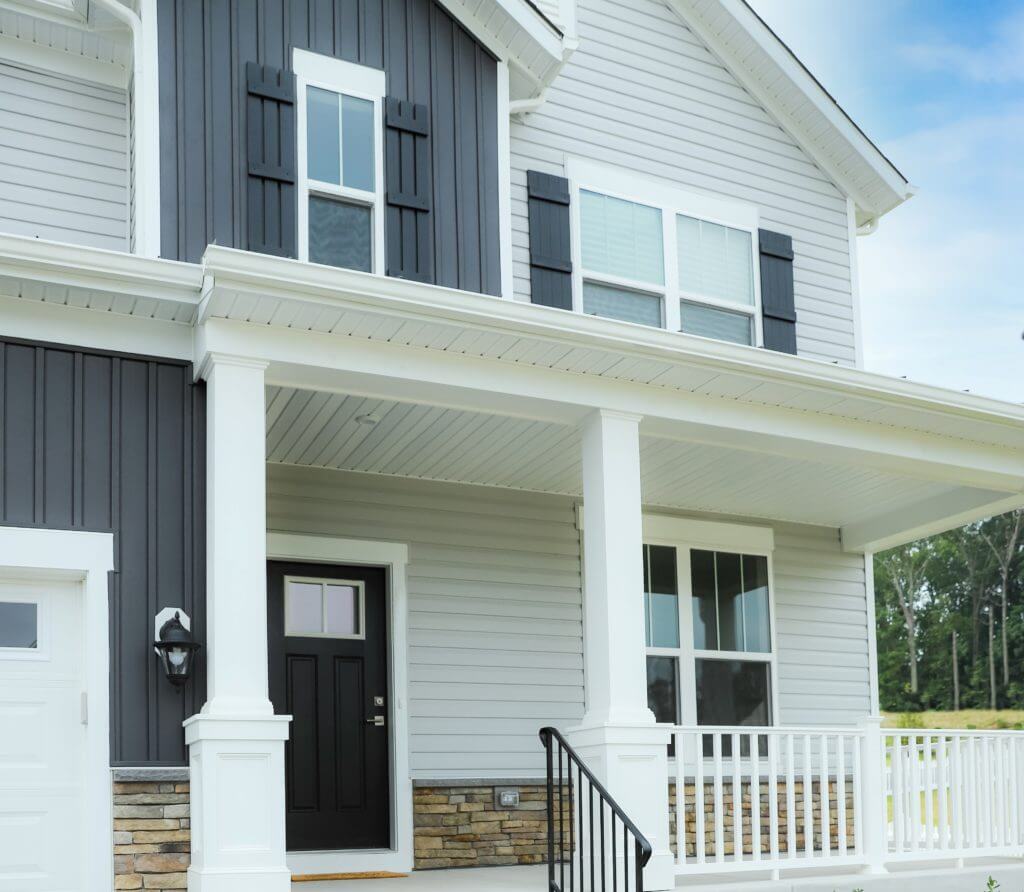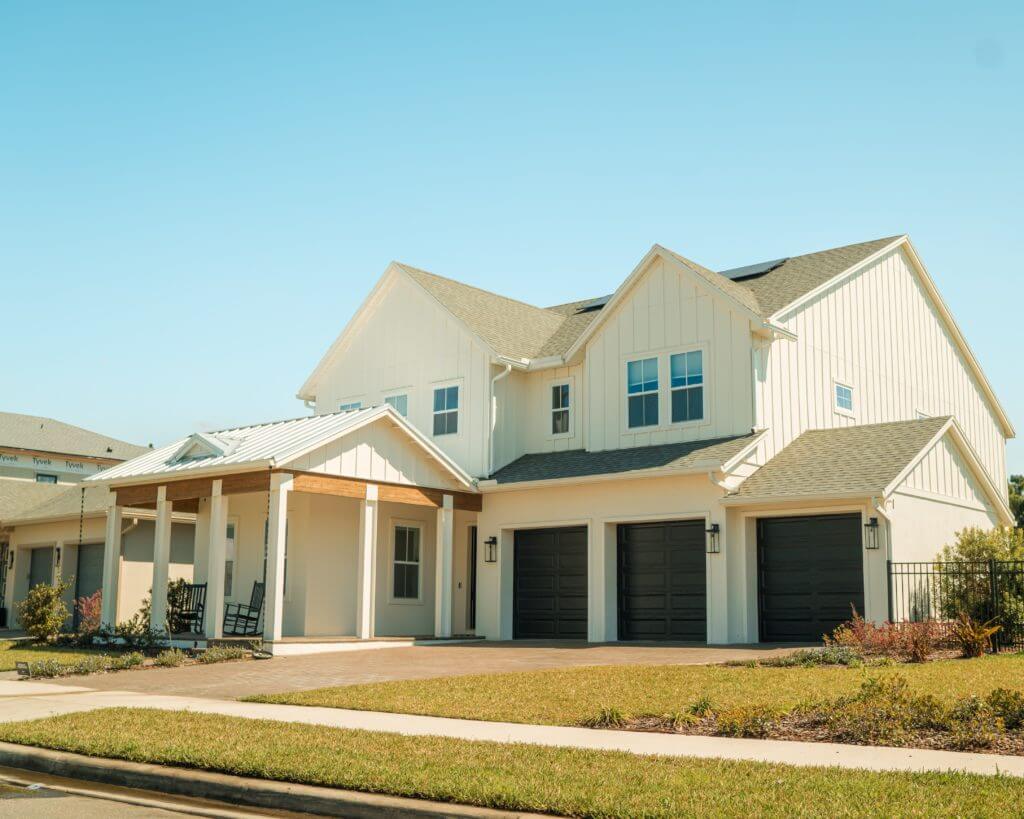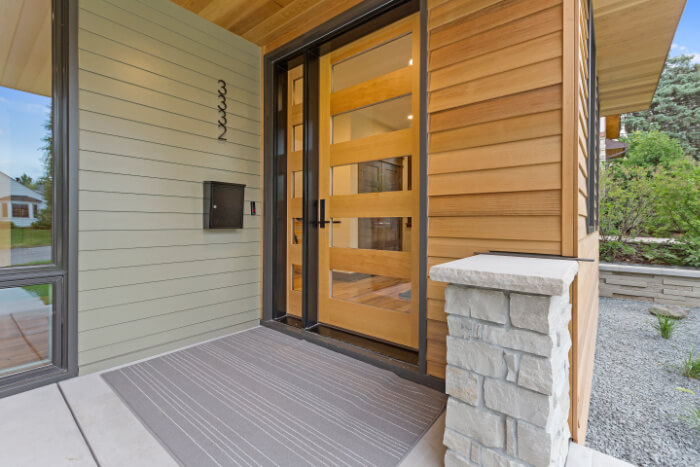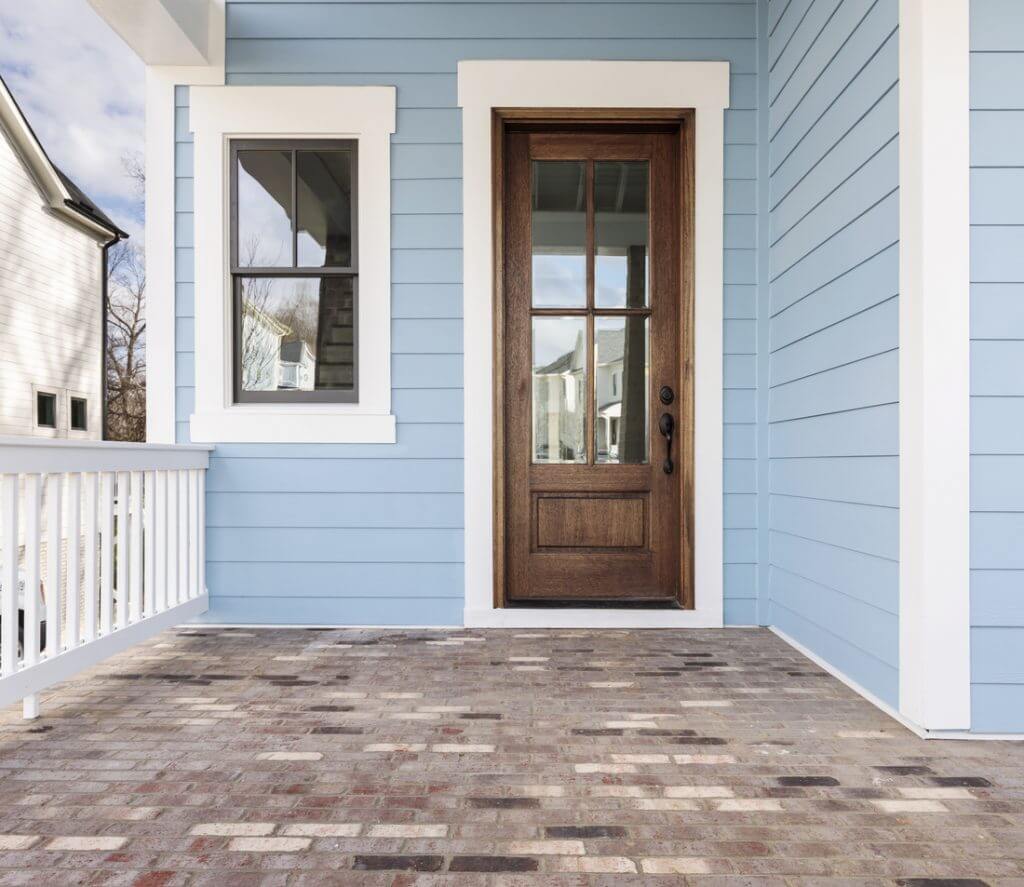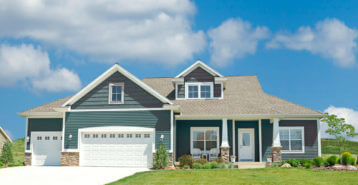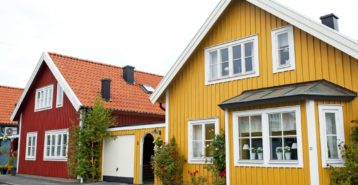- How Much Does Home Siding Cost?
- How Much Does Vinyl Siding Cost?
- Average Cost of House Siding
- Home Siding Cost Calculator
- Home Siding Cost by Material Type
- Siding Style and Design
- Home Siding Cost by House Size
- Other Factors That Affect Cost
- Is New House Siding a Good Investment?
- DIY Siding Installation vs Hiring a Pro
- How to Find a Professional
- Frequently Asked Questions
How Much Does Home Siding Cost in 2025?
You can expect to pay $17,200 for mid-range siding for a 2,000 square foot house, or $8.60 per square foot installed. This project estimate falls toward the higher end of the national average house siding cost range of $2,560 to $20,400.
To reach this average estimate, we looked at cost ranges for five siding types (vinyl, metal, wood, fiber cement, and stucco) as well as how much each material costs to install. Then, we averaged them together to reach the price per square foot above.
The national average cost for new house siding depends on several factors:
- Home size: Larger homes need more siding.
- Location: Material transport and labor rates vary by city.
- Siding material: Vinyl starts at $3 per square foot, but options like metal or fiber cement can cost nearly double.
- Full vs partial replacement: Replacing only damaged areas costs less than full siding replacement.
- Installation complexity: Removing old siding, multi-story homes, or hidden damage all affect the cost. Talk to a contractor for an accurate estimate.
How Much Does Vinyl Siding Cost?
Vinyl is the least expensive of all types of siding at an average cost of $4.50 to $8.20 per square foot installed. However, the most basic vinyl siding can start at just $3 per square foot, and some high-quality options can cost $12 or more per square foot.
Our guide to vinyl siding covers the eight vinyl siding types and how much each cost.
Vinyl siding’s affordability, low maintenance, and durability make it the most popular choice for homeowners in the U.S. However, it’s not ideal for every situation, including:
- Homes in extreme temperatures: Vinyl becomes brittle in cold weather and can warp or fade in intense sunlight.
- Areas prone to wildfires: Vinyl, made of plastic, melt in high heat. Stucco is a better option for fire resistance.
- Environmentally conscious homeowners: PVC vinyl has environmental impacts in both production and disposal.
- Homes with style requirements: Vinyl may not suit historic homes, HOA guidelines, or high-end custom builds.
If any of these apply to you, let’s explore other siding options.
Average Cost of House Siding
In addition to what types of siding are suitable for your area, the top factor influencing your siding choice will be your budget.
The breakdown of the average siding project below will show you that cost is a bit more complex than simply a price per square foot.
Here is an example cost sheet for a vinyl siding project for a home that is just under 2,000 square feet.
| Siding Installation Line Item | Cost |
|---|---|
| Siding installation permit | $200 |
| Finishing strips | $19.80 (6 strips x $3.30 each) |
| Starter strips | $41.75 (15 strips x $2.75) |
| Hydrants, outlets, vents, including hydrant faucets, gable vents, plug-in outlets, and light fixtures | $300.00 |
| Inside corner | $48.60 (9 pieces x $5.40 per piece) |
| Outside corner | $19.70 (2 pieces x $9.85 per) |
| J-channels | $198.00 ($3.60 x 55) |
| Nails | $40.00 |
| Shutters | $468.00 ($39.00 x 12 pieces) |
| Additional costs | $45.00 delivery charge and $250 garbage rental |
| Old siding removal cost | $1,000 |
| Estimated total cost for siding installation | $15,275.35 |
This particular house siding installation example does not include the potential costs of window trimming, soffits, or fascia board.
Unless you have significant DIY experience, you will need a contractor to help you figure out just what’s needed for your own project. That’s why siding prices are represented more simply as “per square foot” costs.
Home Siding Cost Calculator
When you’ve finished using the calculator, you can also ask us to match you with contractors in your area so you can start getting quotes.
Now that you know how siding project costs break down and your estimate, let’s look at the average cost range of siding materials.
Home Siding Cost by Material Type
The type of siding you want will have a significant impact on your project cost. Below, you’ll find a table of the most common siding types (arranged alphabetically), their average cost range per square foot, and their estimated installation cost range for a 2,500-square-foot house.
| Siding Type | Cost Per Square Foot | Installation Cost - 2,500 square feet |
|---|---|---|
| Aluminum | $5.60 - $10.30 | $16,100 - $29,375 |
| Brick Siding | $5 - $15 | $10,000 - $30,000 |
| Fiber Cement | $4.70 - $8.50 | $13,700 - $25,000 |
| Hardie Board | $4.70 - $8.50 | $13,700 - $25,000 |
| Natural Stone | $30 - $48 | $56,000 - 100,000 |
| Stucco Siding | $9.30 - $16.90 | $25,200 - $45,950 |
| Vinyl Siding | $4.50 - $8.20 | $13,325 - $24,300 |
| Wood Siding | $6.90 - $13.90 | $19,300 - $45,175 |
Not sure exactly what type you need? Here’s what to know about each.
Aluminum Siding
Durable, eco-friendly, and weather-resistant, aluminum siding is a popular choice. At $5.60 to $10.30 per square foot, it falls roughly in the middle of siding-type cost ranges. You can read more about it in our guide to aluminum siding cost.
Brick Siding
Brick is one of the most durable siding options, making it an excellent choice if you need something to stand up to extreme weather like storms or intense sunlight. It falls toward the higher end of cost ranges at $5 to $15 a square foot. Our guide to brick siding costs can tell you everything you need to know.
Fiber Cement Siding
Fiber cement siding is rapidly gaining popularity. It has a price point of just $4.70 to $8.50 per square foot, lasts 50 years or more, and unlike vinyl, is extremely weather-resistant, including being highly rated against fire. Our fiber cement siding cost guide can show you the various styles it comes in as well as tell you all about the pros and cons.
Hardie Board Siding
Hardie board is a type of fiber cement siding, so it falls in the same cost range of $4.70 to $8.50 per square foot and shares all of the fiber cement siding’s benefits. The Hardie board brand is especially committed to sustainability. We have a guide specifically devoted to Hardie board siding cost, pros, and cons.
Natural Stone Siding
Gorgeous, low-maintenance, and durable, natural stone siding is one of the most expensive options at $30 to $48 per square foot. The material’s weight makes it expensive to transport and difficult to install. Our guide to natural stone siding can tell you more.
Stucco Siding
Stucco is very popular in the Southwest and Pacific regions since it is fire-resistant, energy-efficient, and low maintenance. It’s one of the more expensive options at $9.30 to $16.90 per square foot. Our guide to stucco siding looks more at that cost as well as its benefits and drawbacks.
Vinyl Siding
The most popular siding choice, vinyl is also the most affordable option at $4.50 to $8.20 per square foot. It comes in many different styles, colors, and sizes, all of which you can check out in our guide to vinyl siding cost.
Wood Siding
Wood siding is a beautiful, classic choice, but also a fairly rare one since wood is both expensive to install and very high-maintenance. It costs $6.90 to $13.90 per square foot. Our guide to natural wood siding can tell you all you need to know.
You can visit our guide to types of siding to see even more options or check out our page on siding installation to see all the factors that might impact the decision you ultimately make.
Siding Style and Design
In addition to the material you choose, how that material gets installed also impacts your cost. Here are a few of the more popular styles of siding that can be installed in.
The more labor needed to install, the more expensive your project will be. For example, long vinyl siding boards installed in a vertical style will be much more affordable than vinyl scallops that need to be installed in an overlapping pattern.
Home Siding Cost by House Size
Your home’s square footage is a good starting point for estimating how much siding you need, but it doesn’t make for an exact match. Your interior living area will not always accurately represent the shape and size of your home’s perimeter.
To get a sense of how much your siding needs and ultimate project cost depend on your unique home, take a look at the table below. To arrive at an estimate, we assumed a mid-range quality siding costing $8.60 per square foot would be used.
| House Square Footage | One or Two Stories? | House Style | Siding Needed | Est. Cost |
|---|---|---|---|---|
| 1,200 | One | Ranch | 1,400 sq. ft. | $12,040 |
| 1,500 | One | Bungalow | 1,100 sq. ft. | $9,460 |
| 2,000 | Two | Cape Cod | 2,480 sq. ft. | $21,328 |
| 2,500 | Two | Cape Cod | 3,200 sq. ft. | $27,520 |
| 3,000 | Two | Custom | 3,840 sq. ft. | $33,024 |
Let’s break down how we calculated each home’s square footage needs.
How Much Siding Does a 1,200 sq. ft. House Need?
To calculate siding for a 1,200 sq. ft. home, we assumed it’s a one-story ranch-style home. Ranch homes are long and narrow, averaging 22 feet wide and 48 feet long. This 1,200 sq. ft. home would need 1,400 square feet of siding.
How Much Siding Does a 1,500 sq. ft. House Need?
For this 1,500 sq. ft. home, we assumed a single-story bungalow. Bungalows are more square-shaped than ranch homes, averaging 25 feet wide and 30 feet long. This home would need 1,100 square feet of siding, less than the 1,200 sq. ft. due to the perimeter’s shape.
How Much Siding Does a 2,000 sq. ft. House Need?
We assumed a two-story cape-style house. Cape homes typically measure 26 feet wide and 36 feet long, so this 2,000 sq. ft. home would need 2,480 square feet of siding.
How Much Siding Does a 2,500 sq. ft. House Need?
For a two-story, 2,500 sq. ft. home, we used common measurements: 35 feet wide and 45 feet long. This home would need 3,200 square feet of siding.
How Much Siding Does a 3,000 sq. ft. House Need?
For a 3,000 sq. ft. home, we selected dimensions of 38 feet wide and 58 feet long. This home would need 3,840 square feet of siding.
Note that all estimates assume an average height of 10 feet for a one-story house and 20 feet for a two-story house.
A contractor can provide a more accurate estimate. You can also measure your home’s perimeter and use these calculations to get an idea of your project’s needs.
How to Estimate How Many Square Feet of Siding You Need
If you want to get a more accurate estimate of how many square feet of siding you need, calculate total wall lengths multiplied by the height of the house.
For example, take a two-story home that is 25 ft. by 45 ft. and is 20 ft. high.
To do the calculation, total the wall lengths, and then multiply by the home’s height. For our fictional two-story house, the calculation is:
25 ft. + 45 ft. +25 ft. + 45 ft. = 140 ft. of wall length
140 x 20 ft. wall height = 2,800 square feet of siding
The example home on which we’ve based these measurements had a 2,250-square-foot interior. There’s more siding needed than there is interior floor space.
Other Factors That Affect Cost
As you’re calculating your project estimate and planning a budget, here are a few other costs to take into consideration as well as some factors that may impact which type of siding you need to choose.
Weather/Regionality
Siding replacement costs are split fairly evenly between materials and labor. While that means choosing a less expensive material can have a large role in lowering your overall cost, you need to ensure that what’s right for your budget is right for your home. Can your siding withstand the seasonal climate of your area? Factors to consider are:
- Your home’s proximity to salty ocean air
- Year-round average temperatures
- Humidity
- Wind
- Rain
- The house’s frequency of exposure to inclement and severe weather such as blizzards, ice storms, tornadoes, and hurricanes.
Labor Cost
As we mentioned above, roughly 50% of your project total will go to labor costs. These can vary by city, with higher cost of living areas having higher labor rates. In addition to installing the siding, labor for this project will cover old siding removal, any repairs needed, and clean-up at the project’s end. We detail each of these factors below.
Removal of Existing Siding
The cost to remove old siding can range from $1,000 to $3,000 or more, depending on the size of the home, the type of siding, and the complexity of the removal process. Some types of siding – like stone, for example – are more labor-intensive to remove than others.
One other thing to keep in mind: do you need to remove and replace all your old siding, or do you simply need to replace certain areas of it? Ask your contractor for their professional opinion and read more about how to tell when you need a full vs partial siding replacement over on our blog.
Repairs Before Installation
Before installing new siding, you may need to repair the underlying structure or sheathing, especially if there has been water damage or pest infestation. Repair costs can vary widely, from a few hundred dollars for minor fixes to several thousand dollars for more extensive repairs. You likely won’t know the extent of repairs needed until the old siding is removed. When getting quotes, ask contractors to explain what they typically find once the old siding is off. This will help you estimate what to add to your budget.t.
Clean-Up
Cleanup costs after siding installation might be included in the overall project quote from some contractors, but if charged separately, they can range from $200 to $600. This cost covers the disposal of old siding and construction debris.
Brand/Quality
The siding brand you choose in addition to a lower-, mid-range, or higher-quality product will also impact cost. You can find our brand picks and which siding type each is best known for over at our guide to best siding brands.
Permits and Inspections
To find out what your city or county requires in terms of permits, contact your local Planning or Development authority. Permit fees are set the city and/or county level and can range anywhere from $50 to $500. Our blog post on understanding siding permits covers this in more depth.
You should also find out if an inspection is required after the project is completed. These are not required in all areas, but asking your contractor or local official about it will save you time and additional fees should you mistakenly ignore the requirement.
Is New House Siding a Good Investment?
Replacing your house siding can yield an 80% rate of return on your investment when you sell your home. If you’re looking to sell your home soon, new home siding is one of the best ways to increase your home’s curb appeal and potential buyer’s interest. High-quality siding types like stone siding or brick siding will increase your home’s value even more.
Even if you are planning to stay in your home for years, your new siding will increase the attractiveness of your home and make it more energy-efficient while you live there. Plus, most siding installations come with a lifetime warranty.
DIY Siding Installation vs Hiring a Pro
Some siding types are easier to install than others. For example, if you’re handy, have a single-story home, and choose an easy siding material, you may be able to do it yourself. Vinyl siding, for instance, is a popular DIY project. You can check out our blog for helpful tips on installing vinyl siding.
However, even vinyl requires careful installation. Every nail or screw can create an entry point for moisture if not done properly. Our blog covers why proper nailing is crucial to ensure a watertight seal.
Ultimately, the best option for proper installation is to hire a professional. They have the expertise, equipment, and insurance to handle multi-story homes, safely remove old siding, and make necessary repairs before installing the new siding. Moreover, you’ll have peace of mind knowing y
How to Find a Professional
Finding a siding contractor you trust can be a stressful part of the process. Getting recommendations from friends, family, and neighbors in your area is a great place to start, and there are, of course, many ways to find a pro online.
No matter how you find them, we recommend using our siding contractor checklist to properly vet the professionals you’re speaking with. We also have a guide on how to compare siding contractor quotes once you’ve got three to four from the pros you like.
If you want to start finding contractors now, you can use our contractor directory to browse through the pros available in your area and request quotes. Modernize can also research for you. Click below to answer a few questions about your siding project, and we’ll match you with up to four pre-vetted contractors.
